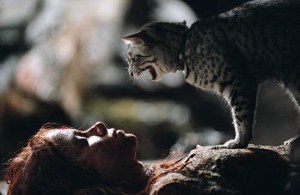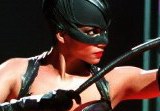|
Catwalks and Cat Scans
 Creating a world in which Catwoman and Patience Philips could believably co-exist necessitated an artful blend of the fantastical and the practical. “We didn't want Catwoman to look like any other action film,” stresses Di Novi. “We wanted to ground the film's world in reality, while stylizing it just enough that it is a bit hyper-real. It also takes place in the world of cosmetics and art and advertising, so there is a level of sophistication that is really glossy and alluring.”
Much of the challenge of creating the brave new visual world of Catwoman fell on the shoulders of production designer Bill Brzeski, visual effects designer/supervisor Ed Jones and their respective teams of designers, decorators and technicians. Both men credit director Pitof and his extensive visual effects background for the freedom they felt in executing their particular design tasks.
Brzeski says that his work on the film was “great fun,” because from a design standpoint, so many of the sets are radically diverse. “We've got everything from Patience's bohemian apartment, to Ophelia's mystical shrine-like house, to the `design for design's sake' cosmetics company headquarters,” says Brzeski. Among his other personal favorites are the cosmetics
factory and the massive photographic layout of Sharon Stone as Laurel Hedare that decorates the company's headquarters, which was created during a two-day photo shoot with renowned photographer Mondino.
Once it was assembled, the immense exhibition made quite an impression on Stone. “When I first walked into the gallery in the boardroom and there were twelve-by-twelve foot photos of me everywhere, it was very intimidating and strange. And then Pitof had the idea to have the pictures grow as Laurel's egomania gets more out of control, so by the end of the movie the pictures are 40 foot tall and there's sixty of them! I finally had to surrender to it, but it was really just too much.”
In addition to rotoscope, motion-control, animation and motion capture technology, visual effects designer Ed Jones also utilized the process known as `universal capture,' which was invented by ESC Entertainment for use in The Matrix Reloaded and The Matrix Revolutions.
All told, over 600 visual effect shots were created for the film. “Utilizing current digital technology, we created 100% synthetic versions of Halle Berry as Catwoman and Midnight the cat for scenes that could not be filmed practically,” says Jones.
“To create the digital replications of Halle, high resolution digital scans, photo references and plaster life-casts were taken. Additionally, we scanned her entire wardrobe to capture all the textural qualities so that we could replicate every detail. We filmed Halle doing a range of emotional facial performances that were then mapped on to her digital double to give us a synthetic character with real facial performances. The goal was to blend the digital characters with the real performers to create seamless, realistic and believable action. Several of the sequences also involved the same digital tools to create the environments virtually. Consequently, there are shots in the movie that are 100% digital.”
THE CAT'S PAJAMAS
In honor of the last day of principal photography on February 20, 2004, many of the Catwoman crew went to work in their pajamas. The reason was two-fold: firstly, to prepare for a well-deserved and perhaps lengthy catnap; and secondly, to celebrate what was for them, the cast and the filmmakers, a truly extraordinary experience.
When asked what she misses most about playing Catwoman, Berry says, “The sense of power, her `don't mess with me' attitude. Playing her I was allowed to live in this altered state for a little while where I could just soar. That feeling of freedom is something that really benefited my own life and it's something that I can carry with me forever. It's in me now and Idon't think it will ever go away.”
|
 catwoman
|